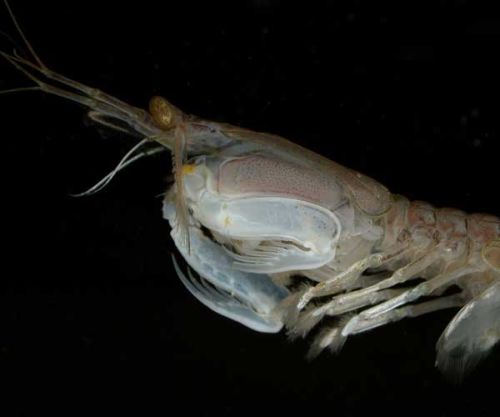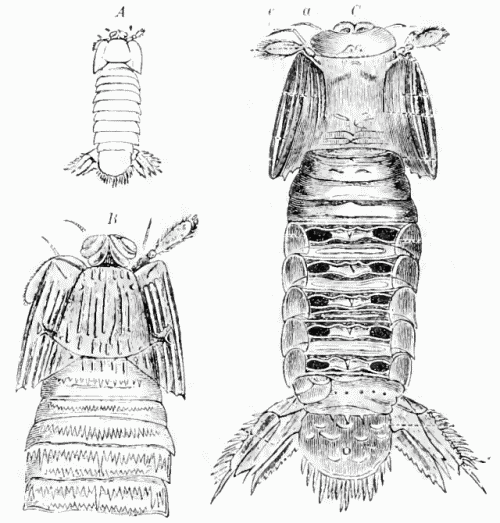
| Palaeos |  |
Malacostraca |
| Arthropoda | Hoplocarida |
| Page Back | Unit Up: Arthropoda | Unit Home | Clade Up: Eumalacostraca | Page Next |
| Unit Back: Ostracoda | Clade Down: None | Dendrogram | References | Unit Next: Decapoda |
|
Abbreviated Dendrogram
CRUSTACEA | `--MALACOSTRACA |--Phyllocarida `--+--Hoplocarida `--Eumalacostraca |--Syncarida |--Peracarida `--Eucarida `--DECAPODA |
Contents
Overview |
Taxa on This Page
 Squilla mantis, showing the spearing appendages Public domain, via Wikipedia. |
|
Close-up of the trinocular vision of Pseudosquilla ciliata Photo by Shumpei Maruyama Wikipedia, Creative Commons Attribution Share Alike/ GNU Free Documentation License,. |
From Wikipedia
Mantis shrimp or stomatopods are marine crustaceans, the members of the order Stomatopoda. They are neither shrimp nor mantids, but receive their name purely from the physical resemblance to both the terrestrial praying mantis and the shrimp. They may reach 30 centimetres in length, although exceptional cases of up to 38 cm have been recorded.[2] The carapace of mantis shrimp covers only the rear part of the head and the first four segments of the thorax. Mantis shrimp appear in a variety of colours, from shades of browns to bright neon colours. Although they are common animals and among the most important predators in many shallow, tropical and sub-tropical marine habitats they are poorly understood as many species spend most of their life tucked away in burrows and holes.[3]
Called "sea locusts" by ancient Assyrians, "prawn killers" in Australia and now sometimes referred to as "thumb splitters" – because of the animal's ability to inflict painful gashes if handled incautiously[4] – mantis shrimp sport powerful claws that they use to attack and kill prey by spearing, stunning or dismemberment. Although it happens rarely, some larger species of mantis shrimp are capable of breaking through aquarium glass with a single strike from this weapon.[5]
References
[2] James Gonser (February 14, 2003). "Large shrimp thriving in Ala Wai Canal muck". Honolulu Advertiser. [3] Ross Piper (2007). Extraordinary Animals: An Encyclopedia of Curious and Unusual Animals. Greenwood Press. ISBN 0-313-33922-8. [4] Gilbert L. Voss (2002). "Order Stomatopoda: Mantis shrimp or thumb splitters". Seashore Life of Florida and the Caribbean. Dover pictorial archive series. Courier Dover Publications. pp. 120–122. ISBN 978-0-486-42068-4. [5] April Holladay (September 1, 2006). "Shrimp spring into shattering action". USA Today.
The following is copied with minor modifications from William Twenhofel and Robert R. Shrock 1935, Invertebrate Paleontology, McGraw Hill Book Co. New York & London, posted at the Internet Archive as public domain. The content has been lightly edited MAK120518
The existing Stomatopods form a very homogeneous group. originally only one family (Squillidae) was recognised. Many of the genera are separated by comparatively slight differences. Representative forms include Squilla, Lysiosquilla, Pseudosquilla, Gonodactyhis Latreille ; and Coronida Brooks. Modern Stomatopods are exclusively marine, the adults generally inhabiting burrows in the sand or mud of the seabottom in shallow water, chiefly in the tropics, but extending also 50 degrees on either side of the equator. Many species seem never to wander far from their burrows, into which they retreat with great rapidity when alarmed. The larval stages, on the other hand, are exclusively pelagic, of glass-like transparency, and occur in great numbers in the plankton of the warmer seas. All the Stomatopods appear to be of active, predatory habits. They range in size approximately from 38 to 340 mm.
 Sculda pennata Late Jura ; Solnhofen , Bavaria, A and B, Dorsal views, C, Ventral aspect, a, e, First and second pairs of antennae, from- Zittel & Eastman 1913. See also Fossils of Solnhofen. |
Stomatopods similar to but generally smaller than modern taxa are known from the Carbonifereous. Perimecturus rapax (Order Palaeostomatopoda ) is known from the Bear Gulch Limestone, and the genus is also known from Scotland, shows several features, such as the massiveness of the abdomen and the movable rostral plate, that suggest an affinity with the group. In the Late Kimmeridgian/Early Tithonian Solnhofen lagerstätte, undoubted Stomatopods occur, some very similar to the Eocene to Recent genus Squilla. Other Solnhofen forms like Sculda (right) and Buria, differ considerably from Recent forms. Larvae of Stomatopods belonging to what is known as the Erichthus type have been recognised in the Cretaceous of the Lebanon. - Zittel & Eastman 1913
Range: From the Carboniferous
Phylogeny: Malacostraca : Phyllocarida + (Eumalacostraca + * )
Characters:. Small carapace and at least four free thoracic segments. The abdomen is large and ends in a tail fan. Twenhofel & Shrock 1935
Comments: There are three orders, the Paleozoic Aeschronectida Schram, 1969 and Palaeostomatopoda Brooks, 1962 and Archaeostomatopoda Schram, 1969, and the Mesozoic and extant Stomatopoda Latreille, 1817 MAK120518
Range: From the Devonian
Phylogeny: Malacostraca : Phyllocarida + (Hoplocarida + * : Syncarida + Peracarida + Eucarida)
Comments: The most successful of the crustacean clades. The main arthropod groups are often distingusihed by different numbers of segments, and the same applies here. Eumalacostracans have 19 segments altogether, devided according to head, thorax, and abdomen; There are five cephalic (head) seqments . There are eight segments in the thorax and the same number of thoracic appendages. The appendages are rarely alike and have the appearance of legs, which are jointed and used for swimming or walking. The abdomen has six segments, all of which may bear appendages. The common ancestor is thought to have had a carapace, and most living species possess one, but it has been lost in some subgroups. The group as originally defined included the Stomatopoda (mantis shrimp), but these are now generally placed in their own subclass, Hoplocarida. Although the earliest forms appeare in teh Devonian, the group only became common in the Triassic, and has continued to flourish ever since - Twenhofel & Shrock 1935, Wikipedia MAK120518
| Page Back | Unit Home | Page Top | Page Next |
Page MAK120518 Creative Commons Attribution